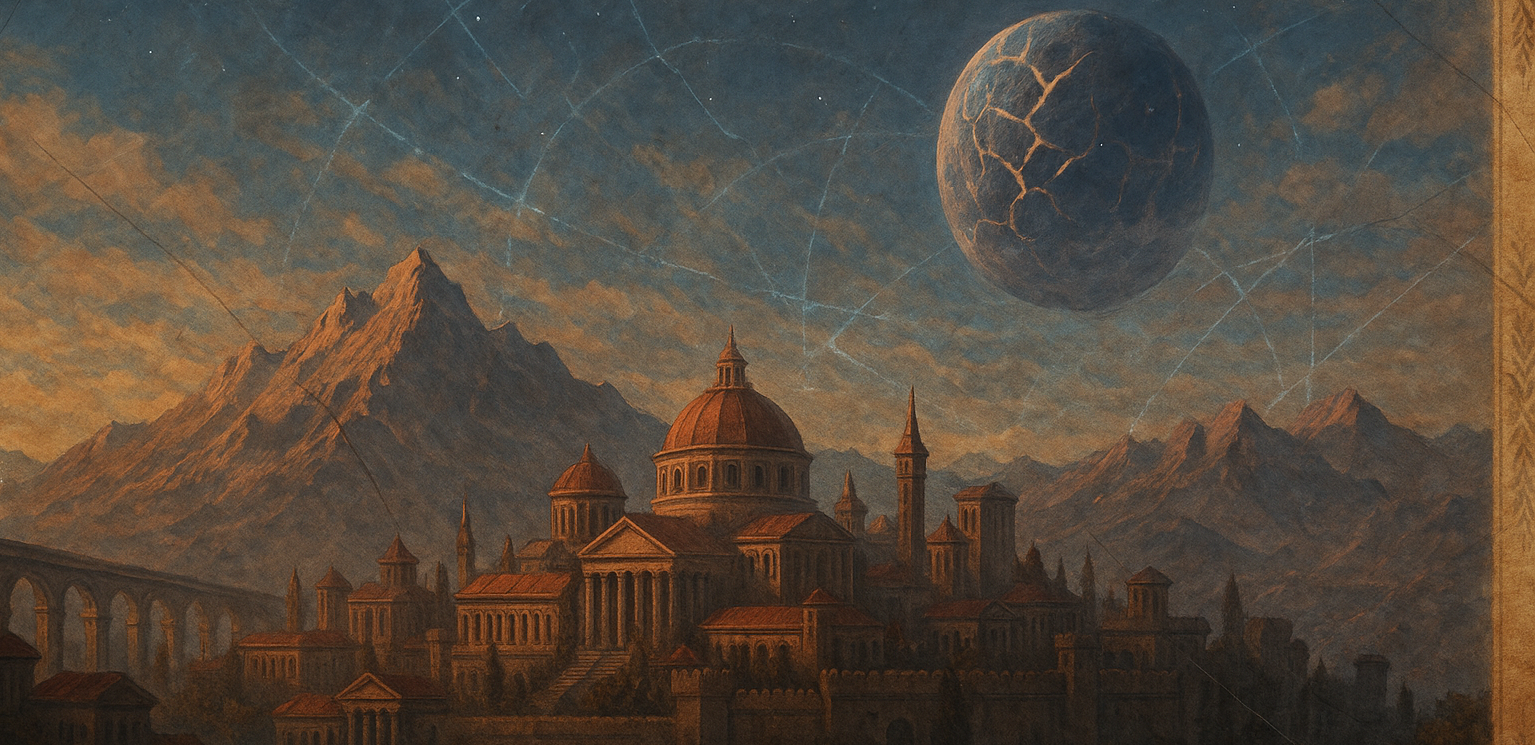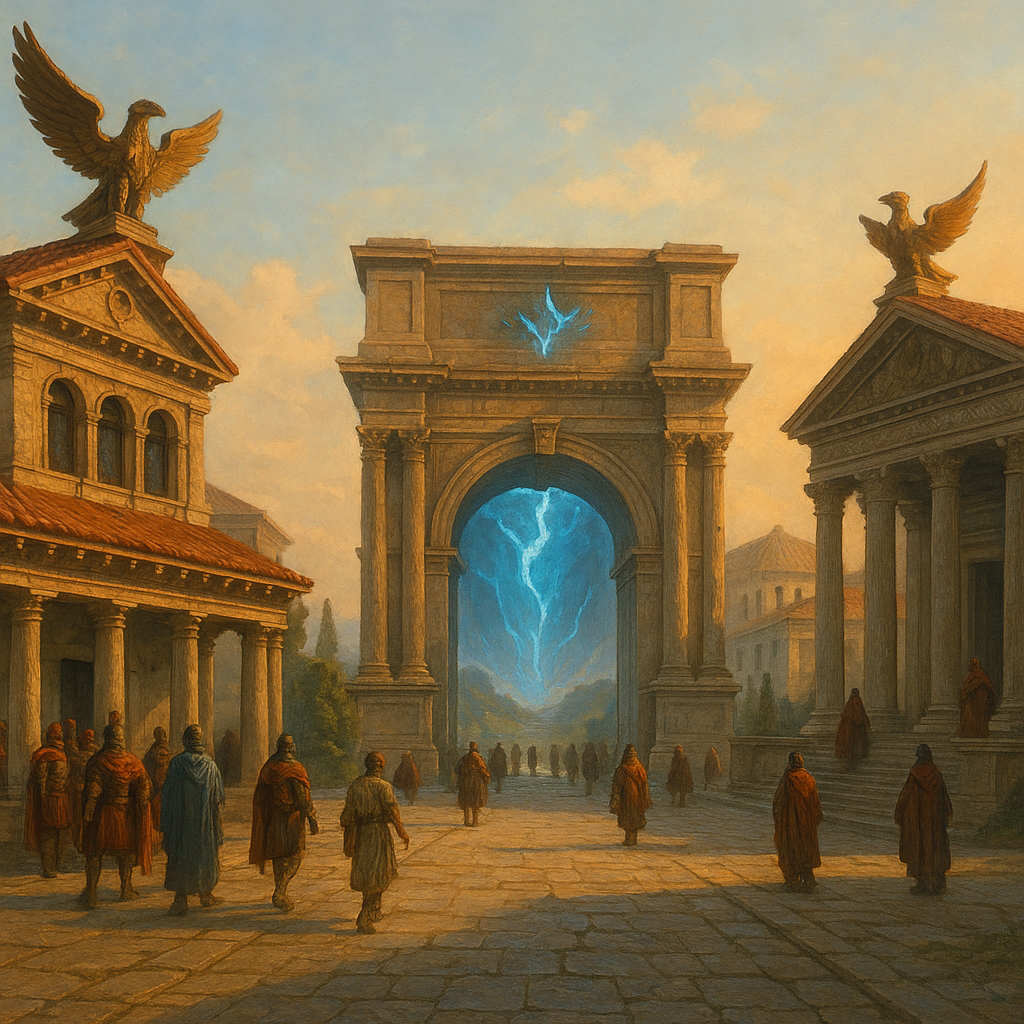The Riftwatch Quarter
District of Nova Roma – Seat of the Arcanii
To walk the streets of the Riftwatch Quarter is to tread the boundary between the rational and the arcane, between the authority of the Codex and the unknowable whims of the Rift. Here, power is not whispered—it is written into stone, spoken in ritual, and enforced by both law and spellcraft.
The Riftwatch Quarter stands as the sovereign domain of the Magisters Arcanii, the locus of magical jurisprudence, arcane regulation, and doctrinal enforcement in the Exiled Imperium. Citizens cross its thresholds with reverence—or trepidation—knowing that within these walls, magic itself is made subject to law.
Culture & Atmosphere
The district resonates with structured solemnity. Here, arcane glyphs are not decorations but legal sigils, embedded into marble, brass, and basalt. Custodians patrol in silent formation; Lexmagi hold public readings of magical statutes; students from the Scholae Arcanii hurry between hearings and conjuration drills.
This is not a place of whimsy nor of free study. It is a place where the right to wield magic is earned, taxed, and tightly governed.
Government
The Riftwatch Quarter is a sovereign enclave within Nova Roma. While nominally under the Imperium's civil jurisdiction, within these walls the Arcanii Tribunal, the Custodians, and the Codex Enforcement Circles hold absolute authority over all matters magical.
Infrastructure
The Quarter itself is a lattice of containment and control. Every street is paved with Riftstone, whose innate resonance dampens excess aether. The walls are inlaid with ley-silver filigree — not for beauty, but for circuitous warding that funnels rogue magic into groundspike diffusers hidden beneath basalt pavers.
Even the sewers are enchanted. Beneath the cobbles flow null conduits, designed to suppress conjuration residues and accidental manifestations. No shadow, no spark escapes surveillance.
Transit within the district is serviced not by common beasts or wagons but by Scriptarii — autonomous rune-bound courier constructs, their forms of brass and Riftglass, whispering along pre-laid sigil lines.
Above it all, suspended between the Riftwatch Towers, stretch the Aetherflow Regulators — bronze conduits that shimmer faintly with controlled ley energy, stabilizing local magical flux. Without them, the Quarter would succumb to its own power.
History
The district rose from necessity in 3 AR, following the first uncontrolled conjuration catastrophe in Nova Roma. It became clear that both magical oversight and a physical locus for its enforcement were needed. Over centuries, the Riftwatch Quarter has evolved from a simple tribunal hall to the fully militarised, doctrinally sovereign enclave it is today.
It has withstood riots from unlicensed mage guilds, internal schisms within the Arcanii, and three recorded Riftflare Events.
Points of interest
The Riftwatch Quarter rises like a testament in stone, its very geometry a declaration of Imperial will imposed upon the chaos of magic. It is no mere collection of streets — it is a designed mechanism, a ritual in marble and basalt.
At its heart stands the Basilica Arcanii, a vaulted colossus of Riftglass, blackstone, and reinforced warded copper. Here, beneath arches lined with floating doctrine sigils, the Tribunal convenes, issuing rulings not merely on mortal disputes, but on the nature of magic itself.
Beneath the Basilica lies the Codex Vault, a place whispered about even among the Arcanii themselves. Within its warded chambers rest the physical tablets of the Codex Exilia, alongside forbidden annexes, lost spells, and the recorded crimes of those who would challenge the arcane order.
To the east rises the Oculus Tharaxis, a circular sanctum open to the sky — or more precisely, to the Rift Moon itself. Here, Visionings are undertaken. Here, Severances are made. It is a place of endings, beginnings, and unmaking.
Arrayed like sentinels are the Riftwatch Towers, slender spires crowned with aether sensors and rune-bound mirrors that shimmer in invisible spectra. Their purpose is vigilance — over the Rift, the ley lines, and the pulse of magic itself.
The Custodian Bastion stands to the southern edge, a fortress not merely of stone but of silence. Its gates are adorned with sigils of binding, and its halls echo with the footfalls of those sworn to enact the Tribunal’s most final decrees.
And yet, not all is rigidity. The Archive of Binding, though guarded, is a place of learning — for those permitted. Here, ritual law is studied, containment protocols refined, and the failures of history chronicled so they are not repeated.
Architecture
The Riftwatch Quarter is not beautiful in the sense of Imperial grandeur nor civic splendor — it is deliberate. Its structures are expressions of containment, of restraint made manifest.
The walls are constructed from black basalt quarried from the Rift Scar itself, each block veined with threads of ley-silver and Riftsteel. These materials are not ornamental — they serve as dampeners, absorbing ambient magical bleed like a sponge.
Facades are dominated by austere geometries: hexagons, interlocking circles, and angular bands of containment glyphs. There are no colonnades for display, no triumphal arches. Instead, structures are ringed with concentric ward circles embedded into the stone itself.
The rooftops are sloped not for rain, but for ward runoff, channeling excess aether into ley gutters that weave like silver veins through the district. These gutters glow faintly at dusk, discharging stabilized energy into earth-grounded regulators hidden beneath plazas.
Windows are rare. Where they exist, they are composed of Riftglass — translucent but polarized against arcane frequencies, appearing from the outside as shimmering sheets of obsidian or mirror-like hex panels.
At key intersections, Custodian Pillars stand — black obelisks engraved with active sigils of Null, Silence, and Bind. They hum softly, a sound felt more in the teeth than in the ears.
The dominant visual motif is weight — walls taller than necessary, doors heavier than practical, lintels that loom as though pressing down on those who pass beneath. Every arch, every facade, every seal reminds the observer: “This is a place where magic bends — or breaks.”
The Basilica Arcanii rises at the center as a singular exception — a towering structure of Riftstone and copper-bound marble whose interior soars into impossible heights, upheld not by columns but by gravitational runes and leyline anchors. Inside, it is paradoxically vast, as though space itself has been folded to create chambers larger within than without.




Comments